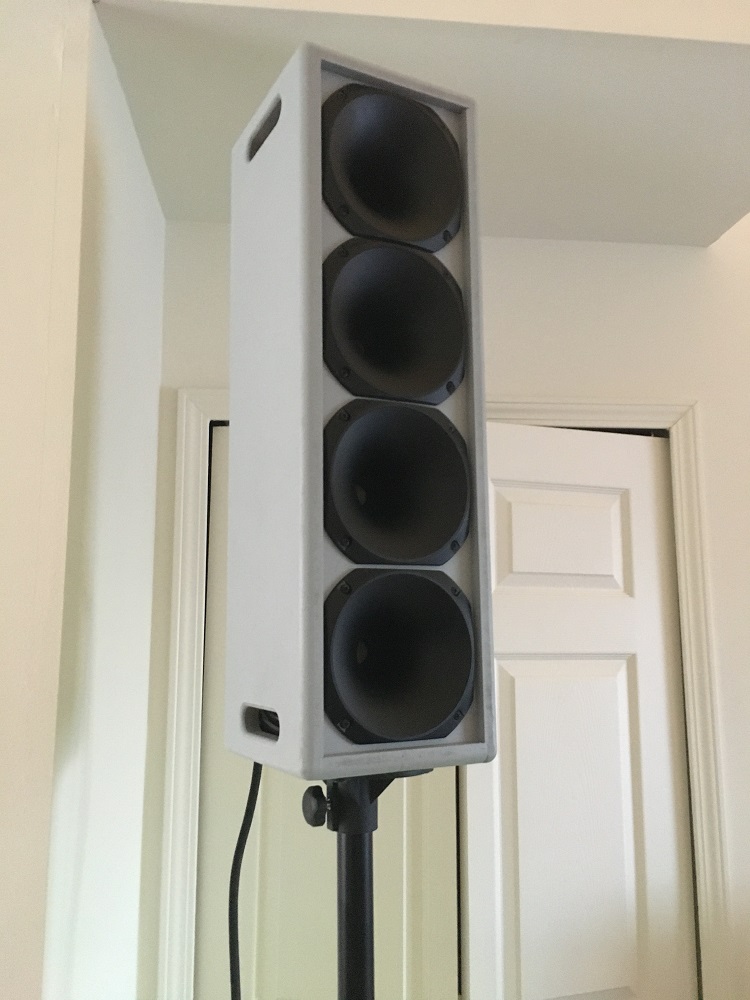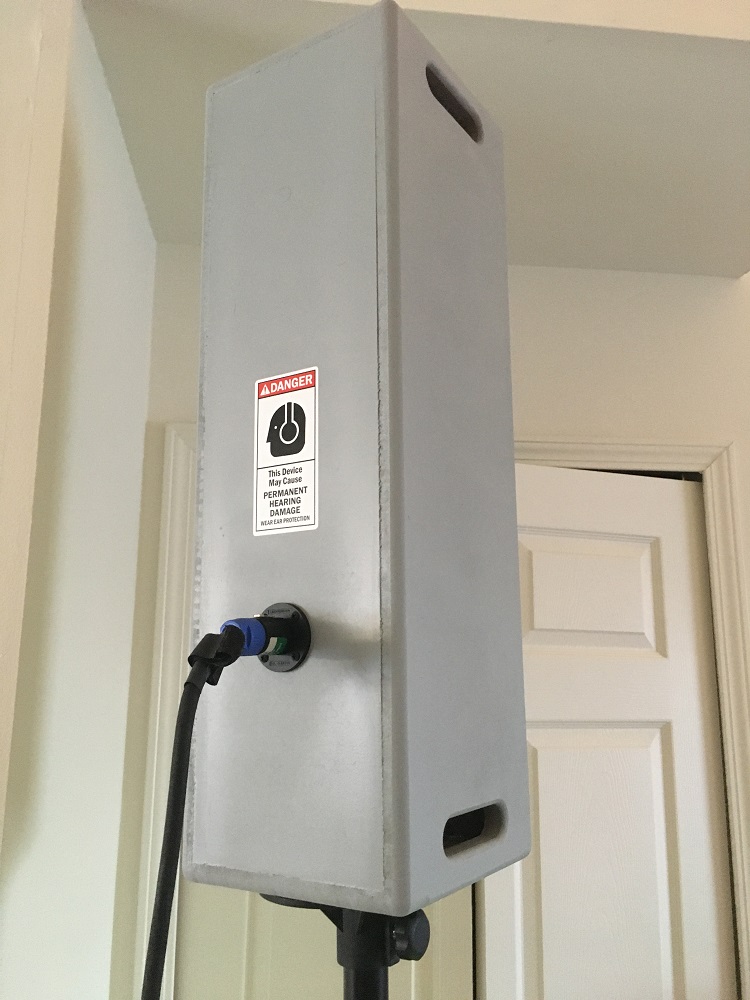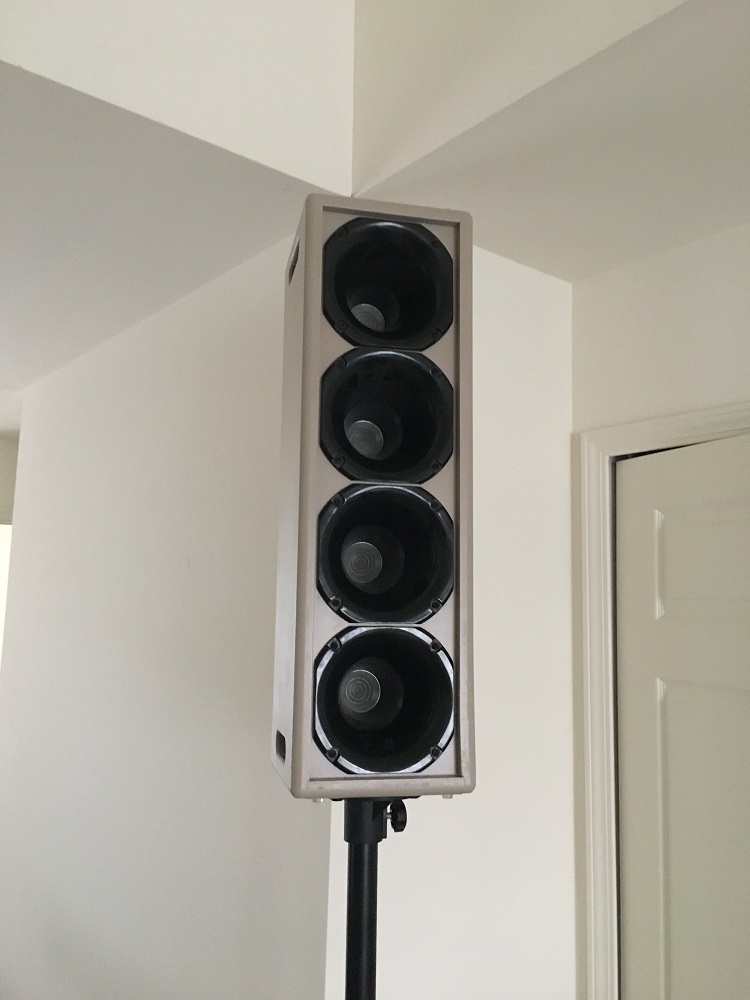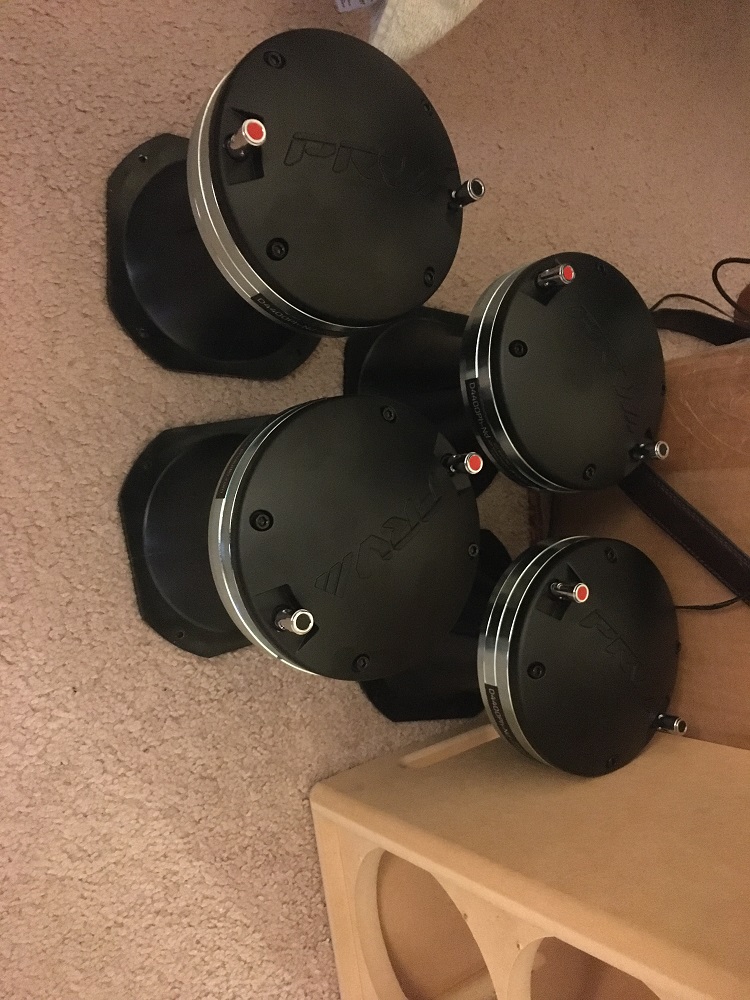
- DJ2226
- Registered User

- Posts: 1429
- Joined: Sat Mar 30, 2013 3:50 am
- Real Name: Dennis Seldon
- YouTube Username: DJ2226
- Location: Columbus, Georgia
Sentry Electronic Siren: The SV-8
As I'm sure many of you all know Sentry introduced their VR series a few years ago. The series didn't really seem to go anywhere, and Sentry ended up dropping the series. They did mention that they had an electronic siren on the way when someone asked them to confirm the series' discontinuation, and the folks at C and K Early Warning Systems gave us a sneak peek at what they had cooking up. They seem to be liking the "boombox" approach to speaker arrays. The VR series used HyperSpike's MA series speakers. I think these are actually something that Sentry has custom-made. I'm not really the biggest fan of this type of speaker arrangement since I think the loaded horn arrays, particularly the diffraction ones that Alertus and SiRcom use, give more of an SPL advantage, but the nice thing about cone drivers like these is they are way more compact and lightweight. It makes them easier to work with. We'll have to see what the official release looks like and if they plan on making larger and smaller versions of this array. They give a range between 110 and 115 dB. That's pretty impressive for a small speaker like this.


Proud owner of a Model 1, SiroDrone, and sketchy MS-790.
DJ2226's YouTube Page
DJ2226's YouTube Page
- Model L
- Global Moderator

- Posts: 628
- Joined: Wed Dec 28, 2016 4:19 am
- YouTube Username: Egress
- Discord: Egress.
- Location: Beaverton, Oregon
Re: Sentry Electronic Siren: The SV-8
will definitely be interesting to see how these pan out. They seem to be pushing them as more of a voice siren, rather than a tone siren, though the fact that it says "electronically generated sound" instead of just tone and voice makes me wonder if they're actually going to have a proper controller, not just an MP3 player this time. sounds like they might have a somewhat competitive product, especially for campus use, where voice intelligibility might be more important.
"Hi-Fi" drivers kinda made me laugh, wonder what music would sound like played through this thing.
"Hi-Fi" drivers kinda made me laugh, wonder what music would sound like played through this thing.
Resident of Beaverton, Oregon
Proud owner of 2 Model L's and a 1984 WS-3000 serial # 717
20 years old
want to chat? send me a request on discord: "egress." or DM me on here.
Proud owner of 2 Model L's and a 1984 WS-3000 serial # 717
20 years old
want to chat? send me a request on discord: "egress." or DM me on here.
- HudsonRiverSirens
- Registered User

- Posts: 761
- Joined: Tue Nov 24, 2020 3:46 pm
- YouTube Username: HudsonRiverSirens
- Discord: gls5768
- Location: Westchester County, NY
- Contact: Website YouTube
Re: Sentry Electronic Siren: The SV-8
This looks really interesting, though this has a lot of similarities to the VR which as you said flopped. Colleges would definitely be in the market for something like this, but ATI and FS seems to dominate most of that market
Sirens may not be sexy, but they sure work.
Proud owner of a 2016 VW Passat.
Proud owner of a 2016 VW Passat.
- ArxCyberwolf
- Registered User

- Posts: 442
- Joined: Tue Sep 01, 2020 2:37 am
- Real Name: Andrew M
- YouTube Username: ArxCyberwolf
- Discord: arxthecyberwolf
- Location: Sarnia, Ontario
- Contact: Website YouTube
Re: Sentry Electronic Siren: The SV-8
Image is broken, "expired url".
Just a wolf, siren enthusiast and railfan.
Rewrote almost the entire ARS Wiki, former admin of the CDS Wiki
Proud owner of an FS&S Model L, Sterling Type F, and soon a mini FS 500AT!
Rewrote almost the entire ARS Wiki, former admin of the CDS Wiki
Proud owner of an FS&S Model L, Sterling Type F, and soon a mini FS 500AT!
-
Taterworks
- Registered User

- Posts: 88
- Joined: Fri Feb 18, 2011 11:49 pm
Re: Sentry Electronic Siren: The SV-8
A prism-shaped housing with line arrays of direct-radiating transducers is covered by a patent owned by Curtis Graber of Wattre, Inc., which is made under license by HyperSpike. That being said, this is not the only way to construct a high-output array of direct radiating transducers. The benefit to Graber's design is that the distance between units radiating at each angle is such that they combine effectively into a single source at most siren warning frequencies, and they are able to be wide-bandwidth system that avoid horn coloration, but they can still experience some pattern lobing at angles throughout 360 degrees at higher frequencies, which would not be experienced by sirens similar to the Whelen WPS, Modulator, or I-Force with their swept 360 degree horns. A few years back, I conceptualized and started designing a direct radiating transducer with reduced horizontal dispersion at high frequencies that would reduce some of the lobing by focusing the output of each rank of transducers into a narrower horizontal beam, using some of Hyperspike's own collimating and directional-focusing technology. But because I don't work for HyperSpike, it probably won't see the light of day.
A couple years ago, I constructed a couple of prototype portable speaker arrays that might be useful for portable and fixed mass notification. The first one used four 6" round horns with 75W 1"-exit siren drivers from PRV Audio. It could get loud, but sound quality was not great. I later found some similar-size round exponential horns that were designed for 2"-exit compression drivers, and I bought four of the best compression drivers I could find for midrange, which were the PRV Audio D4400Ph-Nd, with 4" phenolic diaphragms and huge neodymium magnet structures; today, with the current pricing of neodymium, these drivers would cost a fortune, but I bought them before the current runaway price inflation. These have the ability to play incredibly loud; a single driver has a peak sensitivity of 113dB@1m at 4kHz with 1W input; at the thermal power handling of 800W RMS, the array of four drivers should be able to reach peak output of 153dB at 1m, which works out to 123.5 dB at 100'. The system also has useful bandwidth down to 450 Hz, so it can cover the full speech transmission frequency range with very high intelligibility, and it sounds quite hi-fi. I still need to buy a suitable amplifier and car battery so I can test it in the field. A group of 4 to 6 of these horn arrays, spaced evenly, could cover a wide area. (Also, if 4 were placed side by side with their side walls touching to make a 4x4 grid of horns, they would make an excellent highly-directive array for acoustic hailing, probably able to replace LRAD-type devices.) See below for photos - first the original prototype, then the high-output version. Nothing about it is really patentable, it is just an example of a simple solution for a wide area voice and tone loudspeaker. Another fun fact: The high-output version weighs 60 pounds.
It would be possible for Sentry to manufacture something like the below horn-loaded array and mount multiple ones to a pole (similar to Federal DSA) and possibly avoid existing patents.




A couple years ago, I constructed a couple of prototype portable speaker arrays that might be useful for portable and fixed mass notification. The first one used four 6" round horns with 75W 1"-exit siren drivers from PRV Audio. It could get loud, but sound quality was not great. I later found some similar-size round exponential horns that were designed for 2"-exit compression drivers, and I bought four of the best compression drivers I could find for midrange, which were the PRV Audio D4400Ph-Nd, with 4" phenolic diaphragms and huge neodymium magnet structures; today, with the current pricing of neodymium, these drivers would cost a fortune, but I bought them before the current runaway price inflation. These have the ability to play incredibly loud; a single driver has a peak sensitivity of 113dB@1m at 4kHz with 1W input; at the thermal power handling of 800W RMS, the array of four drivers should be able to reach peak output of 153dB at 1m, which works out to 123.5 dB at 100'. The system also has useful bandwidth down to 450 Hz, so it can cover the full speech transmission frequency range with very high intelligibility, and it sounds quite hi-fi. I still need to buy a suitable amplifier and car battery so I can test it in the field. A group of 4 to 6 of these horn arrays, spaced evenly, could cover a wide area. (Also, if 4 were placed side by side with their side walls touching to make a 4x4 grid of horns, they would make an excellent highly-directive array for acoustic hailing, probably able to replace LRAD-type devices.) See below for photos - first the original prototype, then the high-output version. Nothing about it is really patentable, it is just an example of a simple solution for a wide area voice and tone loudspeaker. Another fun fact: The high-output version weighs 60 pounds.
It would be possible for Sentry to manufacture something like the below horn-loaded array and mount multiple ones to a pole (similar to Federal DSA) and possibly avoid existing patents.




-
Taterworks
- Registered User

- Posts: 88
- Joined: Fri Feb 18, 2011 11:49 pm
Re: Sentry Electronic Siren: The SV-8
Before I forget to ask, any chance of getting the SV-8 photo re-uploaded so we can see it? I'm very curious to see what configuration they are using.
- ArxCyberwolf
- Registered User

- Posts: 442
- Joined: Tue Sep 01, 2020 2:37 am
- Real Name: Andrew M
- YouTube Username: ArxCyberwolf
- Discord: arxthecyberwolf
- Location: Sarnia, Ontario
- Contact: Website YouTube
Re: Sentry Electronic Siren: The SV-8
Taterworks wrote: ↑Mon Apr 25, 2022 12:45 amBefore I forget to ask, any chance of getting the SV-8 photo re-uploaded so we can see it? I'm very curious to see what configuration they are using.

Just a wolf, siren enthusiast and railfan.
Rewrote almost the entire ARS Wiki, former admin of the CDS Wiki
Proud owner of an FS&S Model L, Sterling Type F, and soon a mini FS 500AT!
Rewrote almost the entire ARS Wiki, former admin of the CDS Wiki
Proud owner of an FS&S Model L, Sterling Type F, and soon a mini FS 500AT!
-
Taterworks
- Registered User

- Posts: 88
- Joined: Fri Feb 18, 2011 11:49 pm
Re: Sentry Electronic Siren: The SV-8
Ok, thank you for re-posting the image. That's kind of an interesting design and I like the idea of staggering the speaker magnets to fit them in the cabinet. The speakers they are using are pro sound units made by B&C speakers, and they already have cones that are treated with a waterproofing coating, so they ought to be okay with direct weather exposure for a while as long as UV from direct sunlight doesn't degrade the coating. The enclosure configuration is interesting - I can't be sure whether the Wattre patent will cover the configuration, or whether the well known practice of placing speakers on multiple sides of a square-section or rectangular enclosure will invalidate a patent claim by Wattre or Ultra Electronics if they were to threaten Sentry Siren with patent action. Had Sentry tried building an enclosure with five or more sides with speakers on all adjacent sides, I think it would be vulnerable to a patent claim.
The practice of staggering the speakers on multiple column arrays located on three or more sides of a prism so the magnets or frames can clear each other would also seem to be patentable, and Sentry would have one year from public disclosure to pursue a patent application. This would give Sentry some patent protection if Hyperspike initiated a suit.
In my opinion, one of the less-inspired parts of this design is the steel enclosure. It will be very difficult to reduce the resonances of steel without a lot of added weight, or to keep it from developing buzzes and rattles over time, or leaks that could allow it to fill with water and damage the speakers from behind where they are vulnerable. My preferred solution would be a fiberglass or roto-molded plastic enclosure with a thick wall.
The practice of staggering the speakers on multiple column arrays located on three or more sides of a prism so the magnets or frames can clear each other would also seem to be patentable, and Sentry would have one year from public disclosure to pursue a patent application. This would give Sentry some patent protection if Hyperspike initiated a suit.
In my opinion, one of the less-inspired parts of this design is the steel enclosure. It will be very difficult to reduce the resonances of steel without a lot of added weight, or to keep it from developing buzzes and rattles over time, or leaks that could allow it to fill with water and damage the speakers from behind where they are vulnerable. My preferred solution would be a fiberglass or roto-molded plastic enclosure with a thick wall.
Return to “Main Outdoor Warning Sirens Board”
Who is online
Users browsing this forum: Majestic-12 [Bot] and 47 guests